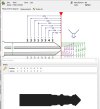I have a local database that I want to search. At the moment I have one column named series. I can change this to two columns if need be. EG Min & Max but I don't think its that straight forward. Some have no letters and others have letter only or a mix of both.
Below is a sample.
When I enter say H2312 I want to return all records where that might be possible.
And another for line 16 below 0L213
Any suggestions on how this might be done or the best way to do it?
Below is a sample.
When I enter say H2312 I want to return all records where that might be possible.
And another for line 16 below 0L213
Any suggestions on how this might be done or the best way to do it?
| Series |
| H0001-H3000 |
| X8001-X9000 |
| S0001-S2000 |
| X0001-X8000 |
| G0001-G2377 |
| P0001-P2390 |
| X0001-X2248 |
| W0001-W2409 |
| 10001-15000 |
| J0001-J1200 |
| 0001X-1706X |
| T0001-T1000 |
| 1-22185 |
| 3001-4481 |
| E5001-E7700 |
| 0K001-0N718 |
| 8001-9554 |
| V2001-V3200 |
| 70000-75928 |
| J00-U39 |
| E0001-E2500 |
| G0001-G2500 |
| HK0001-HK2500 |
| J0001-J2500 |
| K0001-K2500 |
| KE0001-KE2500 |
| L0001-L1037 |
| P0001-P2500 |
| T0001-T2500 |
| V0001-V2500 |
| LK0001-LK2500 |
| 40000-49999 |
| O0001-O5000 |
| D0001-D3000 |
| M0001-M2618 |
| VN0-VN1999 |
| 50000-69999 |
| S4001-S5200 |
| S5298-S6300 |
| G8001-G9000 |
| B8001-B9000 |
| B8001-B9000 |
| K0001-K1000 |
| 10100-12283 |
| 20100-23284 |
| K0001-K1000 |
| N225-N814 |
| U1-U2000 |
| FA0-FA1863 |
| T1-3456 |
| T1-26789 |
| T5-3456 |
| T1-T1200 |
| Y2001-Y3000 |
| 7001-9000 |
| E2001-E3000 |
| E4001-E5000 |
| E5000-E5999 |
| E6001-E7000 |
| E8000-E8999 |
| L8001-L10000 |
| NSP4000-NSP4999 |
| NSP7001-NSP9000 |
| G000-G3631 |
| S000A-S999K |
| 30010-32009 |
| C8001-C9000 |
| Y7001-Y8200 |
| 30001-37850 |
| 40001-41518 |
| 6001-7001 |
| A6001-A7000 |
| D0001-D2000 |
| D4001-D5200 |
| 1HM1-99HM99 |
| 1NF1-99NF99 |
| HM1-HM1200 |
| HM2501-HM3500 |
| HM4001-HM7350 |
| HM6001-HM7110 |
| NF1-NF1200 |
| NM2501-NM3500 |
| 5001-8442 |
| M0001-M1200 |
| 3001-4000 |
| 6001-7000 |
| AB6001-AB6891 |
| N6001-N7000 |
| V1-V3056 |
| V5001-V8058 |
| W1-W9640 |
| 1V00001-5V12295 |
| L000-L999 |
| B1001-B2200 New |
| B1001-B2200 Old |
| B5001-B6200 |
| B5001-B6200 |
| HB1-HB2988 |
| HB3001-HB5000 |
| T1-T2330 |
| HV1-HV854 |
| HV1001-HV1918 |
| HV2001-HV2830 |

